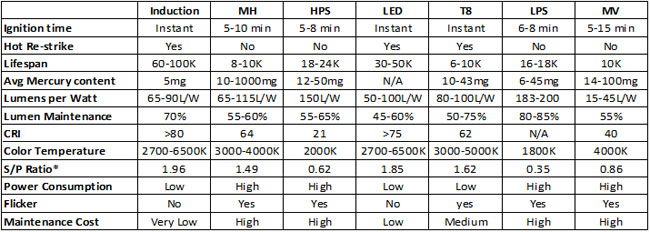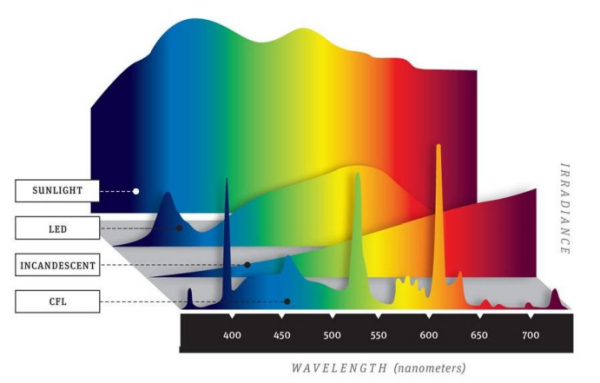LED Interior Color Temperatures
LED interior products are offered in a range from warm white, neutral to daylight white. Anything warmer, e.g. 2700k, gives off yellowish hues and that may be good for skin tones, but not good for commercial retail applications and the illumination of fabrics, food, etc., where rich saturated colors such as red, orange and purples are present.
- The LED Troffers we sell are offered at 3500k, 4000k, and 5000k.
- 6” recessed downlights are offered in 3000k, 4000k, 5000k.
LED Exterior Color Temperatures
Typically, exterior products are offered in the daylight white range. Anything cooler gives off a blue hue and can also distort color perception.
- Parking area lighting is offered at 5200k.
- Exterior wallpacks are offered in 5000k and 5700k.

The Incandescent Bulb
If you start with a yellowish light–like a typical incandescent bulb–you start with a high proportion of light in the red and green range compared to the number in the blue range.
That’s why an incandescent light bulb itself looks yellowish, and it’s also why an incandescent bulb brings out the so-called warmer colors in objects–there’s more red and green available in the light itself to bounce off the object and reach your eye.
The Fluorescent Bulb
If you start with a typical fluorescent bulb, on the other hand, there’s much a much higher percentage of blue available to bounce off the object, and the additional blue brings out the so-called cooler colors in objects where the light bounces.
What Light Makes Me Look Better?
These differences in the light sources explain the common observation that incandescent light is more flattering to people than fluorescent light.
Much the same comment applies to produce, which is why grocery stores avoid standard fluorescent bulbs near fruits and vegetables.
Different Light Source = Different Look
More generally, differences in light sources explain why colors change when you change the light source or color temperature.
Things actually have a different color under daylight than under incandescent light, and a different color still under fluorescent light. In fact, things will have different colors in daylight at different times of day.
Color And Light Sources
By using LED light sources we are able to “dial up” any color of white within the white light range.
The ability of a light source to render or display color depends on the amount of power it radiates or emits in the various regions of the color spectrum.
LED..A "Full Color Spectrum" Light Source
LED is marketed as a “full color spectrum” light source. Other common terms found in the market is “spectrally enhanced lighting” or “scotopically” enhanced.
Good quality LED light sources, fixtures or luminaires radiate or emit a wavelength of light that is more representative of what we see in natural sunlight where the full color spectrum is present.
Light Can Actually Be Brighter Than What Is Measured
Keep in mind though that the color of light has inherent qualities that have not been completely understood, see our article "Scotopic vs Photopic Vision: How Your Eyes Perceive Light Quality".
Recent discoveries in vision science tells us there is more to light than what can be measured and we are beginning to recognize the benefits using LED to generate a full color spectrum of light.
Full Color Spectrum Good For Circadian Rhythm
Using a full color light source like LED with spectra more like daylight improves visual acuity or
sharpness even at lower light levels, has positive effects on the body’s internal clock, (Circadian Rhythm) and generally makes for a better lighting environment.
Want To Learn More?
Check out our , just click on the book below;

